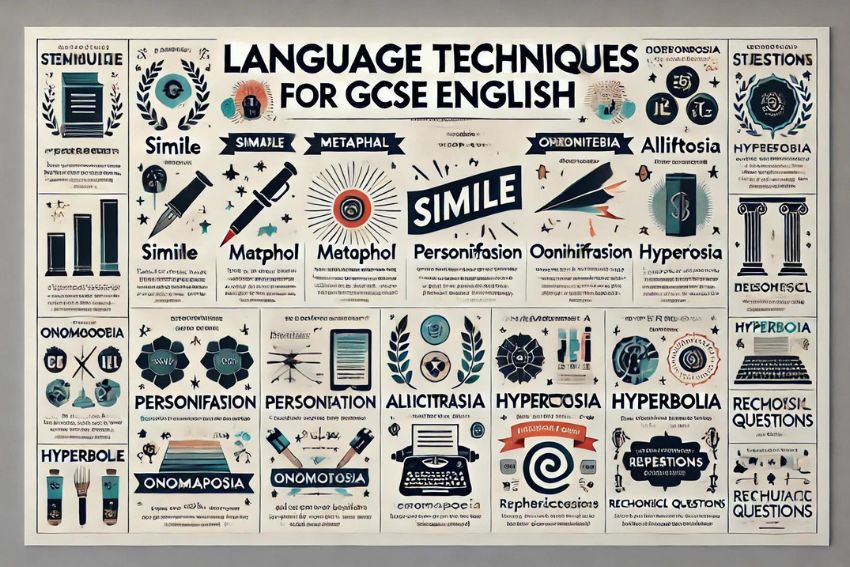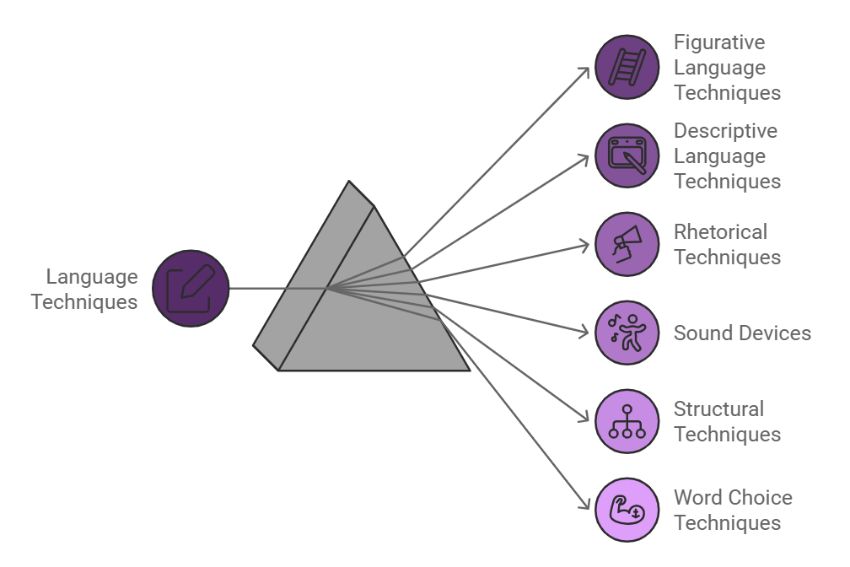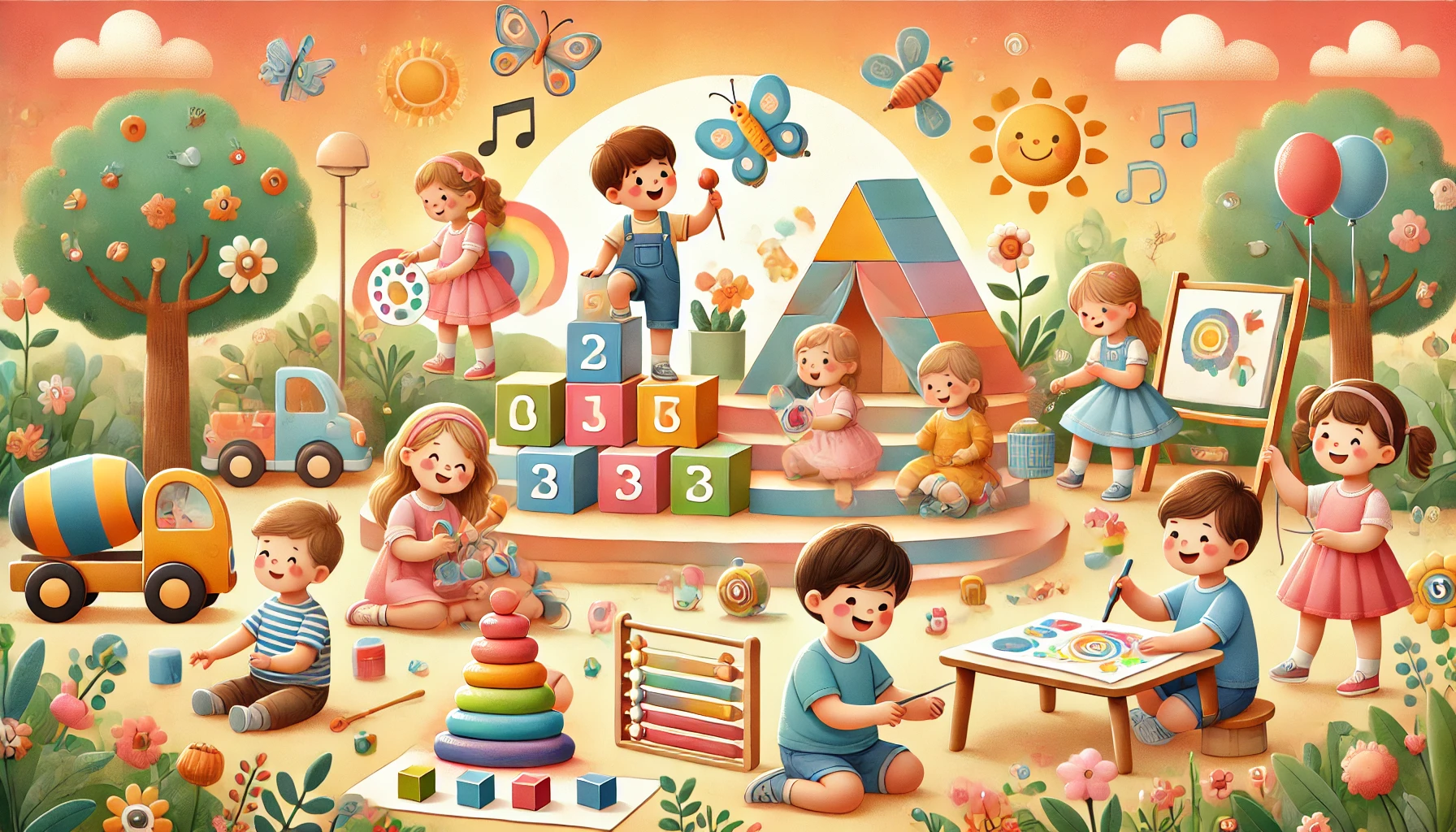This resource is designed to provide GCSE English students with a clear understanding of key language techniques. As you prepare for the exam, it’s essential to not only recognise these techniques but also understand how they function in texts.

Here are 13 language techniques:
Metaphor
What’s a Metaphor?
A metaphor is a figure of speech where a word or phrase is used to represent something else, suggesting a likeness or analogy between them. Unlike a simile, which compares two things using “like” or “as”, a metaphor makes the comparison directly. Metaphors are powerful tools in literature, allowing writers to convey deeper meanings and evoke emotions in a compact form.
Example of Metaphor
Consider the metaphor from Shakespeare’s Macbeth:
“Life’s but a walking shadow.”
Here, life is directly compared to a “walking shadow”, a fleeting and insubstantial image. This metaphor is not just a stylistic choice but is loaded with meaning and emotion, reflecting on the transient and often meaningless nature of life.
Explanation – Effect on a Reader
In this metaphor, Shakespeare doesn’t just describe life as similar to a shadow; he declares it is a shadow. This direct comparison deepens the reader’s understanding of the play’s themes. It prompts readers to think about life’s brevity and existential insignificance, mirroring Macbeth’s own disillusionment. The metaphor encapsulates the essence of the character’s tragic realisation in a single, powerful image, making the abstract concept of life’s fragility more tangible and relatable.
Expert Notes (Variations/Complexities)
Metaphors can vary significantly in their complexity. An extended metaphor continues throughout a passage or an entire work, providing a structural framework that adds layers of meaning. Implied metaphors, on the other hand, suggest the comparison without stating it directly, requiring the reader to infer the connection. Understanding these variations helps in appreciating the depth and richness of literary texts, as writers often use metaphors to add subtlety and nuance to their narratives.
Alliteration
What’s Alliteration?
Alliteration is a stylistic device where consecutive words or words that are close together start with the same consonant sound. This repetition of sounds can create rhythm, mood, and emphasis in a piece of writing. It’s often used in poetry, prose, and even in everyday language like tongue twisters.
Example of Alliteration
An example from J.K. Rowling’s Harry Potter and the Philosopher’s Stone is:
“The big, bad bludger banged against his broom.”
This sentence uses the ‘b’ sound repeatedly to create a rhythmic and emphatic effect. It captures the reader’s attention and mimics the sound of the action being described.
Explanation – Effect on a Reader
In this example, the alliteration of the ‘b’ sound creates a rhythmic beat that emphasises the impact and chaos of the bludger in the Quidditch game. It adds to the intensity and excitement of the scene, making the action more vivid and engaging for the reader. The repeated sound also mirrors the repetitive and forceful nature of the bludger’s movement, enhancing the reader’s sensory experience of the scene.
Expert Notes (Variations/Complexities)
While alliteration traditionally focuses on the repetition of consonant sounds, it can also include vowel sounds in some cases, which is known as assonance. The complexity of alliteration can vary from simple repetitions to more intricate patterns that contribute to the overall tone and mood of a text. Skilled authors may use alliteration subtly to create an underlying rhythm or forcefully to draw attention to specific phrases or themes.
Lists (Rule of Three)
What’s the Rule of Three?
The Rule of Three is a writing principle based on the idea that ideas or phrases presented in threes are inherently more interesting, satisfying, and effective. This technique involves creating a series of three words, phrases, or sentences, which can make the text more memorable and engaging. It’s a common feature in speeches, storytelling, and persuasive writing.
Example of the Rule of Three
A classic example is from Julius Caesar’s famous line:
“I came, I saw, I conquered.”
This simple yet powerful trio of verbs succinctly captures the essence of his swift victory. Each action builds upon the last, creating a sense of progression and completeness.
Explanation – Effect on a Reader
In this historical example, the use of three actions conveys a sense of completeness and finality to Caesar’s triumph. The balanced structure of the phrase makes it easy to remember and rhetorically effective. For the reader, this technique creates a rhythm and progression that emphasise the swiftness and decisiveness of Caesar’s actions. It also provides a clear and concise summary of a complex event, making it more impactful and memorable.
Expert Notes (Variations/Complexities)
The Rule of Three can be adapted in various ways. It can be used in lists of adjectives, actions, or ideas to create a sense of rhythm and emphasis. Additionally, it can be employed structurally in stories, with three-part narratives (beginning, middle, end) or characters. Understanding this technique helps in analysing how writers structure their work to enhance its impact and memorability.
Emotive Language
What’s Emotive Language?
Emotive Language refers to words or phrases that elicit an emotional response from the reader. This language choice can influence the reader’s reaction or create a specific atmosphere in the text. It’s particularly effective in persuasive writing, where the author aims to evoke feelings such as happiness, anger, sadness, or sympathy to sway the reader’s opinion or understanding.
Example of Emotive Language
An example is from Harper Lee’s To Kill a Mockingbird:
“His voice was like the winter wind, cold and ruthless.”
Here, the words “cold” and “ruthless” are charged with emotion, painting a vivid picture of a harsh and unfeeling character.
Explanation – Effect on a Reader
In this instance, emotive language works to create a strong sense of antipathy towards the character being described. The comparison to the “winter wind” evokes a feeling of discomfort and unease, which helps the reader to emotionally connect with the scene and characters. The choice of words like “cold” and “ruthless” not only describes but also conveys the emotional atmosphere, impacting how the reader perceives the character and the narrative.
Expert Notes (Variations/Complexities)
Emotive language can vary in intensity and can be used subtly or overtly. It can be woven into descriptions, dialogue, or narrative to subtly influence the reader’s emotions, or it can be used more directly in persuasive texts to strongly sway the reader’s opinion. Understanding its use is crucial in analysing how authors manipulate language to evoke emotional responses and engage readers on a deeper level.
Personification
What’s Personification?
Personification is a literary device where human qualities are attributed to animals, inanimate objects, or abstract concepts. This technique is used to bring non-human elements to life, making them more relatable and vivid in the reader’s imagination. It’s often employed to create a stronger emotional or imaginative connection between the reader and the subject.
Example of Personification
From William Wordsworth’s poem “I Wandered Lonely as a Cloud”:
“The waves beside them danced.”
In this line, the waves are given the human characteristic of dancing. This not only creates a vivid visual image but also imbues the scene with a sense of joy and liveliness.
Explanation – Effect on a Reader
In this example, personifying the waves as ‘dancing’ transforms the natural scene into one that is full of energy and happiness. It encourages the reader to view the waves not just as a physical phenomenon but as joyful participants in the landscape. This personification draws the reader into the scene, allowing them to experience the landscape not just visually, but emotionally and imaginatively.
Expert Notes (Variations/Complexities)
Personification can be subtle or explicit, and it can be used for a variety of effects. In some cases, it’s used to create a sense of warmth and familiarity with the natural world, while in others, it can add a sense of foreboding or mystery. Understanding personification helps in analysing how authors use this device to convey emotions and themes, and to bring depth and life to their descriptions.
Repetition
What’s Repetition?
Repetition is a literary device involving the deliberate use of a word, phrase, sentence, or sound more than once. It is used to emphasise a feeling or idea, create rhythm, and/or develop a sense of urgency or importance. Repetition can help to reinforce a message or theme in the text.
Example of Repetition
An example can be found in Martin Luther King Jr.’s famous speech “I Have a Dream,” where the phrase “I have a dream” is repeatedly used. This repetition reinforces the central theme of the speech and highlights King’s vision for a future of racial equality and harmony.
Explanation – Effect on a Reader
The repetition of “I have a dream” in King’s speech creates a powerful and memorable rhythm. It not only emphasises the importance of his dream but also helps to instill the idea in the minds of the listeners. For the reader or listener, this repetition acts as a persuasive and motivational tool, reinforcing King’s message and its significance.
Expert Notes (Variations/Complexities)
Repetition can take various forms, such as anaphora (repetition at the start of consecutive sentences or phrases) or epistrophe (repetition at the end of consecutive sentences). The effect of repetition can vary depending on how it’s used – it can create a soothing effect, build suspense, or emphasise a point. Understanding its use is key to appreciating how writers and speakers can skillfully manipulate language to achieve a desired impact.
Opinion
What’s Opinion?
Opinion in literature refers to a statement or a belief held by the writer or a character, which reflects their personal thoughts, feelings, or judgments rather than objective truths. It’s a way for authors to express their viewpoints or for characters to reveal their attitudes and perspectives. Opinions are often used to shape the reader’s understanding of a character or a theme in the narrative.
Example of Opinion
An example can be found in George Orwell’s Animal Farm:
“Four legs good, two legs bad.”
This phrase, repeated by the sheep, reflects their opinion, influenced by the pigs, regarding the superiority of animals over humans. It is a belief that is accepted and repeated without question, representing the indoctrination present in the novel.
Explanation – Effect on a Reader
In Animal Farm, this opinion serves to highlight the power of propaganda and the ease with which simplistic ideas can be used to manipulate and control. For the reader, it underscores the dangers of uncritical acceptance of beliefs and the importance of independent thought. The opinion voiced by the characters becomes a tool for Orwell to convey broader themes about power, control, and the nature of revolutions.
Expert Notes (Variations/Complexities)
Opinions in literature can be expressed directly through the narration or indirectly through the actions and dialogues of characters. They can be used to create conflict, develop characters, or advance the plot. Understanding how opinions are presented and their role in the narrative helps readers to critically engage with the text and explore its deeper meanings and themes.
Onomatopoeia
What’s Onomatopoeia?
Onomatopoeia refers to a word that phonetically imitates, resembles, or suggests the sound that it describes. This literary device is used to create aural effects by echoing the sounds they denote, which can help bring a scene or action to life in the reader’s imagination. Onomatopoeic words are particularly effective in creating vivid, sensory experiences.
Example of Onomatopoeia
A classic example is from Edgar Allan Poe’s poem “The Bells,” where words like “tinkling,” “jingling,” and “tintinnabulation” mimic the sounds of bells. These words not only describe the sound but also imitate the actual sounds of the bells, enhancing the sensory experience of the poem.
Explanation – Effect on a Reader
The use of onomatopoeia in “The Bells” adds a lyrical and rhythmic quality to the poem, making it more engaging and immersive. For the reader, these sounds bring the poem to life, allowing them to ‘hear’ the bells as they read. This auditory stimulation creates a more dynamic and interactive reading experience, deepening the reader’s connection to the text.
Expert Notes (Variations/Complexities)
Onomatopoeia can vary from simple, direct mimicry of sounds to more subtle and imaginative uses, where the sound of the word is used to convey a mood or atmosphere. Some onomatopoeic words are universally recognised, while others may require more creative interpretation. Understanding onomatopoeia enriches the reader’s appreciation of how language can be used to create sensory experiences and add depth to literary descriptions.
Facts/Figures
What are Facts/Figures?
Facts/Figures in literature refer to the use of data, statistics, or factual information to support arguments, create realism, or add credibility to the narrative. While often associated with non-fiction, facts and figures can also be effectively used in fiction to lend authenticity or to emphasise a particular point or theme.
Example of Facts/Figures
An example is from Mark Haddon’s The Curious Incident of the Dog in the Night-Time. The protagonist, Christopher, often uses facts and figures to explain his understanding of the world, like when he details his knowledge of prime numbers or explains scientific concepts. These factual details provide insight into his character and his way of viewing the world.
Explanation – Effect on a Reader
The use of facts and figures in this novel helps to create a sense of realism and to develop Christopher’s character. For the reader, this use of factual information provides a window into Christopher’s unique perspective, characterised by logical and factual thinking. It also adds depth to the narrative, making it more engaging and relatable.
Expert Notes (Variations/Complexities)
In literature, facts and figures can be employed in various ways. They can be used to add detail and depth to a setting, to develop a character’s personality or background, or to support thematic elements of the story. In some cases, authors may use factual information selectively or with a degree of artistic license to suit the narrative. Understanding how and why facts and figures are used can enhance a reader’s ability to critically analyse and appreciate the text.
Rhetorical Question
What’s a Rhetorical Question?
A rhetorical question is a question asked not to get an answer, but rather to emphasise a point or create a dramatic effect. It’s a persuasive technique used to provoke thought or to emphasise a conclusion or point that is generally understood by the reader. Rhetorical questions are common in both literature and speeches.
Example of Rhetorical Question
From William Shakespeare’s Julius Caesar, Mark Antony asks:
“Friends, Romans, countrymen, lend me your ears; I come to bury Caesar, not to praise him. The evil that men do lives after them; The good is oft interred with their bones; So let it be with Caesar. The noble Brutus hath told you Caesar was ambitious: If it were so, it was a grievous fault, And grievously hath Caesar answer’d it.
Here, under leave of Brutus and the rest – For Brutus is an honourable man; So are they all, all honourable men – Come I to speak in Caesar’s funeral. He was my friend, faithful and just to me: But Brutus says he was ambitious; And Brutus is an honourable man. He hath brought many captives home to Rome Whose ransoms did the general coffers fill: Did this in Caesar seem ambitious? When that the poor have cried, Caesar hath wept: Ambition should be made of sterner stuff: Yet Brutus says he was ambitious
And Brutus is an honourable man. You all did see that on the Lupercal I thrice presented him a kingly crown, Which he did thrice refuse: was this ambition? Yet Brutus says he was ambitious; And, sure, he is an honourable man. I speak not to disprove what Brutus spoke, But here I am to speak what I do know. You all did love him once, not without cause: What cause withholds you then, to mourn for him? O judgment! thou art fled to brutish beasts, And men have lost their reason. Bear with me; My heart is in the coffin there with Caesar, And I must pause till it come back to me.”
Explanation – Effect on a Reader
In this speech, Antony uses rhetorical questions to subtly challenge Brutus’s claims about Caesar’s ambition, planting doubt in the minds of the listeners. Each question invites the audience to question Brutus’s judgment and motives, while ostensibly maintaining a respectful tone. For the reader, these rhetorical questions highlight the manipulative power of language and the complexity of political rhetoric.
Expert Notes (Variations/Complexities)
Rhetorical questions can be used in a variety of contexts, from persuasive essays to dramatic monologues. They can be straightforward or loaded with irony, as seen in Antony’s speech. Understanding how rhetorical questions function can help readers appreciate the nuances of argumentation and persuasion in literature, as well as their impact on character development and plot advancement.
Exaggeration
What’s Exaggeration?
Exaggeration is a literary device where a statement is made to be more significant or more intense than it actually is. It’s used to emphasise a point, create a dramatic effect, or evoke humor. In literature, exaggeration can be a powerful tool to convey emotions, create character traits, or highlight certain situations.
Example of Exaggeration
A humorous example is from Douglas Adams’ The Hitchhiker’s Guide to the Galaxy:
“The ships hung in the sky in much the same way that bricks don’t.”
This exaggerated comparison humorously emphasises the improbable and unusual nature of the spaceships’ ability to float in the air.
Explanation – Effect on a Reader
This exaggeration by Adams effectively captures the reader’s attention with its absurdity, creating a vivid and humorous image. It serves to highlight the quirky and unconventional nature of the novel’s universe. For the reader, such exaggerations not only provide entertainment but also help in visualising the extraordinary scenarios presented in the story.
Expert Notes (Variations/Complexities)
Exaggeration can take many forms, from hyperbolic statements to elaborate descriptions that stretch the bounds of reality. While often used for comedic effect, it can also be employed to convey intense emotions or to stress the significance of an event or characteristic. Understanding its use in literature helps readers appreciate the creative ways writers engage their audiences and embellish their narratives.
Allusion
What’s Allusion?
Allusion is a literary device where the writer makes a reference to a person, place, event, literary work, myth, or work of art, either directly or by implication. This technique allows the writer to convey complex ideas and emotions succinctly, drawing on the reader’s prior knowledge and associations with the reference.
Example of Allusion
In F. Scott Fitzgerald’s The Great Gatsby, there are numerous allusions to contemporary and historical events and figures, such as World War I and the Jazz Age. These allusions help to set the context of the story and deepen the reader’s understanding of the characters and their motivations.
Explanation – Effect on a Reader
The use of allusions in The Great Gatsby provides depth and layers to the narrative, offering a richer reading experience. For readers familiar with these references, it adds a level of sophistication and helps in drawing parallels between the novel and real-world events and cultures. It can also evoke emotions and associations, enhancing the thematic resonance of the story.
Expert Notes (Variations/Complexities)
Allusions can vary in their obscurity and complexity. Some may be widely recognised, while others might be more subtle or esoteric, requiring specialised knowledge. They can enrich a narrative by adding layers of meaning, creating connections, and eliciting deeper responses from the reader. Understanding allusions in a text can greatly enhance one’s appreciation of the author’s craft and the depth of the narrative.
Direct Address
What’s Direct Address?
Direct address is a literary technique where the narrator or a character speaks directly to the reader, another character, or an abstract concept or object. This device can create a sense of intimacy, urgency, or immediacy, and is often used to engage the reader more deeply, break the fourth wall, or provide insight into a character’s thoughts or feelings.
Example of Direct Address
In Charlotte Brontë’s Jane Eyre, the protagonist often speaks directly to the reader, as in “Reader, I married him.” This direct address engages the reader personally and creates a sense of closeness and complicity between Jane and the reader.
Explanation – Effect on a Reader
This famous line from Jane Eyre establishes a personal connection with the reader, inviting them into the narrative. It creates a moment of intimacy and draws the reader closer to Jane’s inner world and emotions. This technique helps in developing a strong bond between the reader and the protagonist, making the narrative more engaging and relatable.
Expert Notes (Variations/Complexities)
Direct address can be employed in various ways in literature. It can be used to make the reader a confidant, to challenge or provoke thought, or to create a reflective or introspective tone. It can appear in narratives, poems, and plays, and its effectiveness often depends on the context and the skill with which the author uses it. Understanding direct address helps readers appreciate the ways authors can break traditional narrative boundaries to create more dynamic and interactive texts.
What are examples of Language Techniques?

Here are some key examples of language techniques commonly found in GCSE English exams. These techniques help writers create meaning, evoke emotion, and engage the reader.
1. Figurative Language Techniques
- Metaphor – A comparison between two things without using “like” or “as.”
Example: “Time is a thief.” - Simile – A comparison using “like” or “as.”
Example: “Her smile was as bright as the sun.” - Personification – Giving human traits to non-human objects.
Example: “The wind whispered through the trees.”
2. Descriptive Language Techniques
- Imagery – Vivid descriptions that appeal to the senses.
Example: “The golden leaves crunched beneath my feet.” - Sensory Language – Descriptions involving the five senses (sight, smell, touch, taste, hearing).
Example: “The aroma of freshly baked bread filled the room.”
3. Rhetorical Techniques
- Rhetorical Questions – Questions posed to make the reader think, not to be answered.
Example: “Isn’t it time for a change?” - Direct Address – Speaking directly to the reader using “you.”
Example: “You have the power to make a difference.” - Emotive Language – Words and phrases used to stir an emotional reaction.
Example: “This tragic loss left the entire community heartbroken.”
4. Sound Devices
- Alliteration – Repetition of the same initial consonant sound.
Example: “Peter Piper picked a peck of pickled peppers.” - Onomatopoeia – Words that imitate sounds.
Example: “The bees buzzed and the leaves rustled.” - Assonance – Repetition of vowel sounds within words.
Example: “The rain in Spain stays mainly on the plain.”
5. Structural Techniques
- Repetition – Repeating words or phrases to emphasise an idea.
Example: “We must act now, we must act together, we must act boldly.” - Juxtaposition – Placing contrasting ideas side by side for impact.
Example: “It was the best of times, it was the worst of times.” - Foreshadowing – Hinting at future events in a story.
Example: “Little did she know, this would be the last time she saw him.”
6. Word Choice Techniques
- Hyperbole – Extreme exaggeration for emphasis.
Example: “I’m so hungry I could eat a horse!” - Connotation – Implied or associated meaning of words.
Example: The word “home” connotes warmth, safety, and comfort. - Tone – The writer’s attitude towards a subject, e.g., serious, humorous, sarcastic.
- Semantic Field – A collection of related words that share a common theme or idea.
What are language devices?
Language devices are deliberate choices that shape how a text sounds, feels, and persuades, such as metaphor, simile, imagery, alliteration, contrast, and rhetorical questions. In literature studies, these sit within the wider category of literary devices, which also includes structural and narrative techniques like foreshadowing, symbolism, irony, and flashback.
Why Language Techniques Matter
Language devices (also called language techniques) are essential for both analysis and creative writing tasks in GCSE English. They show how language influences meaning, mood, and the reader’s response. Identifying and explaining these techniques is a key part of GCSE exam success.
If you’d like more detail on any of these techniques or need help understanding how to analyse them, let me know!
How to Write a Speech for GCSE
You are maybe wondering, how to write a speech for GCSE? Writing a good speech can be a fluency exercise if given a good framework and some level of rehearsal. First, one must be clear about the intended purpose and for whose sake the audience is. Simply speak to inform, convince, or entertain your specific audience.
Plan your structure and then work it through, starting with an introduction that leads the reader into the main body in a clear structure and a fulfilling ending. Begin by hooking the reader with a question, quote, or fact to get some attention before outlining your main points
Construct each argument using examples and evidence and ensure smooth transitions between sections in other words, post-powerfully by summarising your key points and ending with a memorable statement. Layer your speech with rhetorical devices, for example, repetition or emotive language, then rehearse with someone to build your confidence and delivery. These steps will set you up to write a solid and engaging GCSE speech. You may also find this GCSE speech ideas helpful.
Usefull Resourses
BBC Bitsesize
Master English Language techniques for GCSE with this comprehensive guide from BBC Bitesize. From persuasive language and structure through stylistic devices, it’s all explained clearly here, with examples to boot.
Whether it’s improving your understanding when analysing literature or writing fluently, you’ll find easily accessible content from BBC Bitesize to help enable you to perform highly at your exams. This will be very useful in enhancing your knowledge and raising your confidence about English Language.
For more information, visit the BBC Bitesize English Language.
AQA
The AQA GCSE English Language specification gives an overview of the structure of any assessment with details on what is covered during the course. It provides specific information about two examination papers: Paper 1, on the viewpoints or perspectives presented by writers and Paper 2, that focuses on creative reading and writing. These will be accompanied by a non-examination assessment in spoken language for presenting, responding to questions, and using Standard English. This ensures that, through the specification, learners develop relevant reading, writing, and oral communication skills.
For more details check the official website: AQA GCSE English Language Specification.
Save My Exams
For students preparing for their GCSE English Language exams, Save My Exams offers a wealth of resources to support effective revision. The website features a variety of practice papers, topic questions, and revision notes tailored to the GCSE English Language syllabus. These materials are designed to help students build confidence and master key techniques required for exam success. With content specific to exam boards such as AQA, Edexcel, and OCR, Save My Exams is a comprehensive tool for GCSE English Language preparation.
You can explore their resources here.
Conclusion
In conclusion, understanding these language techniques is crucial for your success in GCSE English Paper 1. By recognising and analysing these devices in texts, you enhance not only your comprehension but also your ability to express your insights effectively.
If you find yourself needing further clarification or assistance, remember that help is just a click away. Edumentors, an online tutoring platform, offers specialised support from experienced GCSE English tutors. Their guidance can provide you with the additional assistance needed to excel in your studies. Good luck with your preparation, and don’t hesitate to reach out to Edumentors for expert support in your English literary journey.
FAQs:
What are the 7 language features in English?
The 7 key language features in English are:
- Imagery – Use of vivid descriptions and sensory language to create mental images for the reader. This includes metaphors, similes, and personification.
- Alliteration – Repetition of the same initial consonant sound in closely positioned words, e.g., “Peter Piper picked a peck of pickled peppers.”
- Hyperbole – Deliberate exaggeration to create emphasis or effect, e.g., “I’ve told you a million times!”
- Onomatopoeia – Words that imitate natural sounds, like “buzz,” “sizzle,” or “clang.”
- Personification – Giving human characteristics to non-human objects, e.g., “The wind whispered through the trees.”
- Rhetorical Questions – Questions asked for dramatic effect rather than a direct answer, e.g., “Isn’t it obvious?”
- Repetition – Repeating words, phrases, or ideas for emphasis or to reinforce a message.
These language features are frequently used in GCSE English and A-Level English analysis. Let me know if you’d like more details or explanations for any of them.
What is a technique in English GCSE?
A technique in English GCSE refers to a specific method or literary device used by writers and speakers to create meaning, convey themes, or evoke emotions in the reader or audience. Techniques are essential for analysing texts in GCSE English Language and Literature, as students are often asked to identify and explain their effects.
Common Techniques in English GCSE
- Narrative Techniques – How the story is told, such as point of view (first-person, third-person) or the use of dialogue and monologue.
- Literary Devices – Tools like metaphors, similes, personification, and symbolism used to add depth and meaning to writing.
- Structural Techniques – How a text is organised, including sentence structure, paragraphing, flashbacks, and foreshadowing.
- Language Techniques – Specific choices in vocabulary, tone, and style, such as the use of alliteration, hyperbole, and rhetorical questions.
What is Language and Techniques?
Language and techniques in English refer to the methods, devices, and tools that writers use to communicate their message, engage the reader, and create specific effects or meanings in their work. These are essential concepts in GCSE English Language and Literature, where students must identify and analyse how authors use language and techniques to convey ideas, evoke emotions, and build themes.
What are language devices?
Language devices are techniques that writers and speakers use to make their words more powerful, engaging, and memorable. They can help emphasise ideas, create emotion, or persuade an audience. Common examples include:
- Metaphors and similes – comparing things to create vivid images.
- Alliteration – repeating the same sound at the start of words.
- Rhetorical questions – questions asked to make a point, not to get an answer.
- Imagery – descriptive language that appeals to the senses.
- Repetition – repeating words or phrases for emphasis.
These devices are often taught in English lessons because they appear in speeches, stories, poetry, and even adverts. Understanding them can help students analyse texts more effectively and improve their own writing.
What is an example of a language feature?
An example of a language feature is metaphor. A metaphor is a figure of speech where one thing is described as if it were something else, to create a vivid image or deeper meaning.
Example of a Metaphor:
“Time is a thief.”
Here, time is compared to a thief, suggesting that it “steals” moments from our lives. The comparison adds emotional depth and creates a stronger impact on the reader.
Other Examples of Language Features
Alliteration – Repetition of initial consonant sounds.
Example: “The slippery snake slithered silently.”
Simile – A comparison using “like” or “as.”
Example: “Her smile was as bright as the sun.”
Personification – Giving human qualities to non-human objects.
Example: “The leaves danced in the wind.”
Hyperbole – Exaggeration for emphasis.
Example: “I’ve told you a million times to clean your room!”
Onomatopoeia – Words that imitate sounds.
Example: “The thunder rumbled and the rain splashed.”
Imagery – Vivid descriptions that appeal to the senses.
Example: “The fragrant aroma of fresh-baked bread filled the warm kitchen.”
Repetition – Repeating words or phrases to emphasise a point.
Example: “Never give up. Never back down. Never surrender.”
Emotive Language – Words that evoke emotions in the reader.
Example: “The heartbreaking news left the entire community in shock.”
Symbolism – When an object, colour, or action represents a larger idea.
Example: A white dove symbolising peace.
Connotation – The implied or associated meaning of a word.
Example: The word “home” suggests warmth, comfort, and security beyond its literal meaning of a house.
How to get a 7 in GCSE English Language?
To get a Grade 7 in GCSE English Language, follow these key strategies:
- Master Language Techniques – Learn to identify and analyse techniques like metaphors, similes, and rhetorical devices in texts.
- Perfect Exam Structure – Plan answers using clear introductions, analysis paragraphs (PEE: Point, Evidence, Explanation), and strong conclusions.
- Practise Writing Skills – Develop creative writing and transactional writing skills (letters, articles, speeches) with engaging openings, vivid descriptions, and varied sentence structures.
- Time Management – Practise past papers under timed conditions to get used to exam pressure.
- Improve Vocabulary – Use a wider range of vocabulary and avoid simple, repetitive words.
- Focus on SPAG – Ensure your spelling, punctuation, and grammar are accurate to avoid losing easy marks.
- Revise Past Papers – Identify question trends and learn how examiners award marks.
Consistency and regular practice are key to achieving a Grade 7 or higher.








